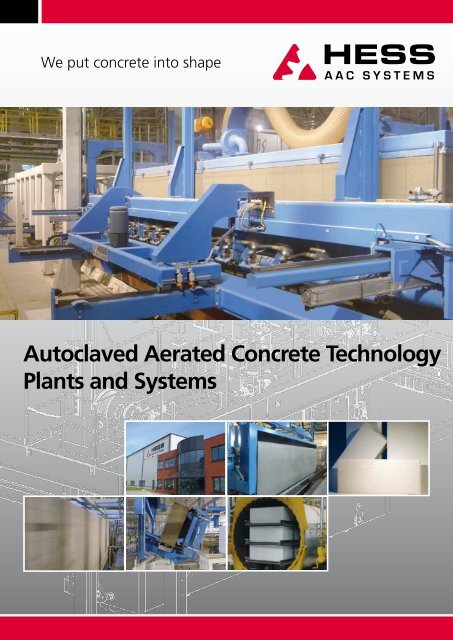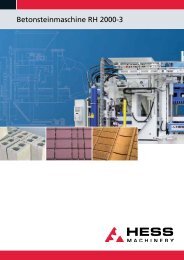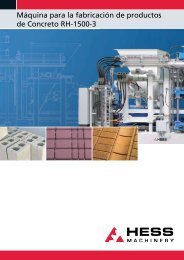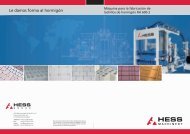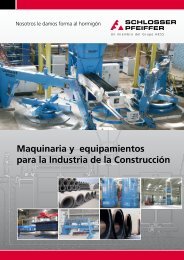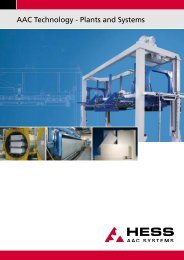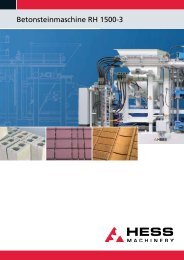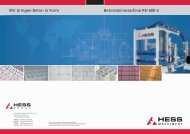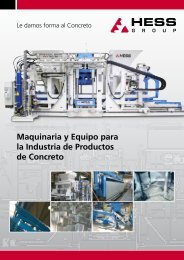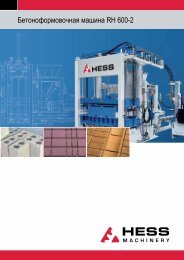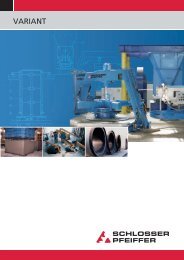Autoclaved Aerated Concrete Technology Plants and ... - HESS Group
Autoclaved Aerated Concrete Technology Plants and ... - HESS Group
Autoclaved Aerated Concrete Technology Plants and ... - HESS Group
Create successful ePaper yourself
Turn your PDF publications into a flip-book with our unique Google optimized e-Paper software.
<strong>Autoclaved</strong> aerated concreteThe <strong>Autoclaved</strong> <strong>Aerated</strong> <strong>Concrete</strong> (AAC) materialwas developed in 1924 in Sweden. It hasbecome one of the most used building materialsin Europe <strong>and</strong> is rapidly growing in manyother countries around the world.<strong>Autoclaved</strong> <strong>Aerated</strong> <strong>Concrete</strong>, also known asAircrete, is a lightweight, load-bearing, highinsulating,durable building product, whichis produced in a wide range of sizes <strong>and</strong>strengths.AAC offers incredible opportunities to increasebuilding quality <strong>and</strong> at the same time reducecosts at the construction site.AAC is produced out of a mix of quartz s<strong>and</strong><strong>and</strong>/or pulverized fly ash (PFA), lime, cement,gypsum/anhydrite, water <strong>and</strong> aluminium <strong>and</strong>is hardened by steam-curing in autoclaves. Asa result of its excellent properties, AAC is usedin many building constructions, for example inresidential homes, commercial <strong>and</strong> industrialbuildings, schools, hospitals, hotels <strong>and</strong> manyother applications.The construction material aircrete contains60% to 85% air by volume. The solid materialpart is a crystalline binder, which is calledTobermorite by mineralogists. Besides the bindingphase Tobermorite aircrete contains grainsof quartz <strong>and</strong> in minor amounts some otherminerals. The chemical composition of Tobermoriteshows silicium dioxide, calcium oxide<strong>and</strong> water.The silicium dioxide is obtained from silicas<strong>and</strong>, fly ash (PFA), or crushed quartzite. It ispossible to obtain silicium dioxide as a by-productfrom other processes, e.g. foundry s<strong>and</strong>.The calcium oxide is obtained from quick lime,hydrated lime <strong>and</strong> cement. Gypsum/Anhydriteis added in small quantities as a catalyst <strong>and</strong> foroptimizing the properties of AAC. Aluminiumpowder / paste is used as exp<strong>and</strong>ing agent.Adv<strong>and</strong>ayes of AAC• Large variety of sizes: AAC can be producedin a large variety of sizes, from st<strong>and</strong>ardblocks to large reinforced panels;• Excellent thermal insulation: AAC has avery low thermal conductivity <strong>and</strong> thereforea very high thermal energy efficiencyis achieved.This results in cost savings forheating <strong>and</strong> cooling;• Extremely lightweight: AAC weighs approximately50% less than other comparablebuilding products;• High compressive strength: AAC is a solidproduct, therefore making it highly loadbearing. The entire surface area is used instructural calculations;• High dimensional accuracy: As a result ofits dimensional accuracy, AAC is extremelyeasy to install, as no thick set mortar isrequired;• Great acoustic insulation: The porousstructure of AAC provides a high acousticinsulation;• High fire resistance: AAC has an extremelyhigh fire resistance rating of at least 4hours <strong>and</strong> more;• Termite resistance: AAC can not be damagedby termites or insects;• High workability: As a result of the excellentsize/weight ratio, AAC allows rapidconstruction work. Even though AAC is asolid building material, it can be cut, sawn,drilled, nailed <strong>and</strong> milled like wood, makingit an easily workable product2 3
Production processReinforcement preparationThe <strong>HESS</strong> systems are also ideal for the production of large format reinforced panels. Dependingon the required capacity, the reinforcement cages are outsourced or welded on site. The cagesare then assembled per mould <strong>and</strong> hung onto holding frames with cross bars <strong>and</strong> needles. A corrosionprotection is then applied. Immediately after the mix has been poured into the mould, thewaiting reinforcement frame assembly is inserted. Before cutting of the cake the holding frameswith needles are lifted, leaving the reinforcement in the cake.Raw material preparation <strong>and</strong> mixingA ball mill wet-grinds the quartz s<strong>and</strong> with water to a s<strong>and</strong> slurry. The s<strong>and</strong> slurry is stored in slurrytanks <strong>and</strong> pumped into the slurry weighing hopper in the mixer tower. The binders (lime, cement<strong>and</strong> anhydrite) are stored in silos. It is also possible to mill the anhydrite together with the s<strong>and</strong> inthe ball mill. The aluminum powder or paste is prepared in a separate building where it is dispersedin water.All the components are accurately weighed, <strong>and</strong> are released into the mixer in a pre defined order.The <strong>HESS</strong> recipe <strong>and</strong> temperature control system constantly monitors this process.<strong>HESS</strong> also has the knowledge <strong>and</strong> the experience to produce AAC with alternative raw materials,for example with fly ash.Casting, rising/pre-curing <strong>and</strong>mould circulationThe mould consists of four fixed sides <strong>and</strong> one detachableplatform. The inner mould surfaces are coveredwith demoulding release oil before casting.This oil is applied either manually or automatically.The mix is then poured into the moulds. A mouldcirculation system conveys the moulds to the risingarea, where the cake pre-cures for 2-3 hours afterwhich it is ready for cutting. Depending on the plantdesign, the moulds are h<strong>and</strong>led by a mould traverseror by the tilting-manipulator.TiltingThe <strong>HESS</strong> systems are also idealfor the production of large formatreinforced panels. Dependingon the required capacity,the reinforcement cages are outsourcedor welded on site. Thecages are then assembled permould <strong>and</strong> hung onto holdingframes with cross bars <strong>and</strong> needles.A corrosion protection isthen applied. Immediately afterthe mix has been poured into themould, the waiting reinforcementframe assembly is inserted.Before cutting of the cake theholding frames with needles arelifted, leaving the reinforcementin the cake.6 7
CuttingThe cake is cut by high precision cutting machines.Cutting is done by cutting knives <strong>and</strong>by pneumatically tensioned cutting wires.• the pre-cutter <strong>and</strong> vertical cutter cutthe block length <strong>and</strong> panel width. Inthis station the profiling (tongue <strong>and</strong>groove) can be cut into the cake withprofiling knives;• the horizontal cutter cuts the block <strong>and</strong>panel thickness;• the cross cutter cuts the block height<strong>and</strong> the panel length. Optionally h<strong>and</strong>gripscan be milled in the blocks in thegreen sdaye.8 9
Back-tilting <strong>and</strong> bed removalIn most tilt-cake systems the cake is autoclaved inthe vertical position. The <strong>HESS</strong> plants have combinedthe adv<strong>and</strong>ayes of the tilt-cake <strong>and</strong> flat-cakesystem.After the cutting is completed, the cake is tilted backby 90° onto a cooking frame. In the <strong>HESS</strong> systemno part of the mould or platform used for cuttinggoes into the autoclaves. After the cake has beentilted back into the horizontal orientation, the bottom/bedwaste will be removed before autoclaving.Autoclaving the cake while lying horizontally on thecooking frames allows efficient autoclave loading<strong>and</strong> most importantly, will prevent most of the stickingof the layers, which is a typical disadv<strong>and</strong>ayeof the traditional tilt-cake systems.<strong>HESS</strong> SYSTEMS PRODUCE NOPROCESS RELATED WASTE!Green separationOne of the <strong>HESS</strong> innovations is the green separator.Here the horizontal cuts (now lyingvertical) are carefully separated before autoclaving,leaving a small gap in between the layers.This innovation eliminates any sticking, whichis typical for other tilt-cake systems. Further thisgreen separation substantially improves the autoclavingprocess as steam can penetrate intothe cake more effectivety.Frame <strong>and</strong> bogey circulationThe green cakes on the cooking frame are stackedthree high onto autoclaving cars, referred toas bogeys. Autoclave buffer tracks in front of theautoclaves ensure that the cutting <strong>and</strong> packagingprocesses are less dependent on one another. Anautoclave traverser is used for loading <strong>and</strong> unloadingthe autoclaves, ensuring that this process isperformed in the shortest possible time, in order tooptimise autoclaving capacity.AutoclavingIn the autoclaves the cakes are cured for ca. 10 – 12hours at a temperature of 190° C with saturatedsteam at a pressure of 12 bar. The fully automaticautoclave control system ensures a safe <strong>and</strong> optimalautoclaving process, also allowing for steam transfer<strong>and</strong> energy reutilization in combination with thecondensate system.10 11
Process control <strong>and</strong> plant automationThe entire production process is controlled by modern automation systems designed by <strong>HESS</strong>on the basis of Siemens S7 control system using st<strong>and</strong>ard components that are available worldwide.User-friendly, multi-lingual operator interfaces with touchscreen monitors allow easy <strong>and</strong>underst<strong>and</strong>able operation. The <strong>HESS</strong> remote diagnostic system allows for the possibility of onlinesupport.Unloading <strong>and</strong> packingAfter autoclaving is completed, the cakesare destacked <strong>and</strong> unloaded from the cookingframes. <strong>HESS</strong> offers a large variety ofpackaging solutions, ensuring that the finishedproducts are packed according to localmarket requirements. Usually blocks will bedelivered as packs on wooden pallets, strapped<strong>and</strong>/or covered in foil.<strong>HESS</strong> also offers a wide range or post-autoclavingh<strong>and</strong>ling for reinforced products,such as packaging lines, sawing <strong>and</strong> shapingsystems.Process know-how<strong>HESS</strong> has a modern laboratory equippedwith all necessary equipment <strong>and</strong> apparatusto perform vital raw material tests. Not onlythe raw material characteristics are checked,but also small scale AAC productionis possible, allowing <strong>HESS</strong> to gain importantinformation on raw material production behaviour<strong>and</strong> final product quality.12 13
ModificationsTechnical Data - AAC <strong>Plants</strong>Compact Line – CBTCBT-200 CBT-300 CBT-400Theoretical capacity 200 m³ / day 300 m³ / day 400 m³ / dayCakes / day 75 112 150Cycle time 18,0 min / cake 12,0 min / cake 9,0 min / cakeNo. of autoclaves (32 m) 2 3 4No. of rising places 9 13 17Net cake size 3,0 x 1,5 x 0,6 m = 2,7 m³Keen-Crete® Line – KBT-SKBT-S-450 KBT-S-650 KBT-S-900Theoretical capacity 450 m³ / day 650 m³ / day 900 m³ / dayCakes / day 84 126 167Cycle time 16,1 min / cake 10,7 min / cake 8,1 min / cakeNo. of autoclaves (43.7 m) 2 3 4No. of rising places 10 14 19Net cake size 6,0 x 1,5 x 0,6 m = 5,4 m³Keen-Crete® Line – KBTKBT-900 KBT-1100 KBT-1350 KBT-1550Upgrade of existing Hebel type cutting systemsIn order to increase the quality of the productas well as the reliability of the plant, withoutinvesting in a complete new cutting machine,the modification of the Hebel technologybased cutting machine is possible.• cutting table with moving bridges• needles with rectangular design• ballance opposed double set of cross cuttingshafts• vertical wire tensioning system• top crust removal system• horizontal cutting system for lintel cutting• counter pusher with pusher package• bottom <strong>and</strong> top profiling system• control system• hydraulic systemHighlights• short installation time• proven technology• the existing logistics <strong>and</strong> production technologydo not require major changes<strong>HESS</strong> can also undertake the modification ofother AAC plant systemTheoretical capacity 900 m³/ day 1.100 m³/ day 1.350 m³/ day 1550 m³/ dayCakes / day 167 204 250 288Cycle time 8,1 min / cake 6,5 min / cake 5,3 min / cake 4,6 min / cakeNo. of autoclaves (43.7 m) 4 5 6 7No. of rising places 19 24 28 33Net cake size 6,0 x 1,5 x 0,6 m = 5,4 m³Keen-Crete® Line – KBT-LKBT-L-1550 KBT-L-1750 KBT-L-2000Theoretical capacity 1550 m³/ day 1750 m³/ day 2000 m³/ dayCakes / day 288 330 370Cycle time 4,7 min/ cake 4,1 min/ cake 3,7 min/ cakeNo. of autoclaves (43.7 m) 7 8 9No. of rising places 32 37 41Net cake size 6,0 x 1,5 x 0,6 m = 5,4 m³Based on a pre-curing time of 2,5 h <strong>and</strong> on 2 autoclave cycles/day. These are dependent on raw materials <strong>and</strong> product mix. Other autoclave lengths<strong>and</strong> net cake volumes are possible <strong>and</strong> will change the capacity data. Reinforced products with a length of max. 6 meters can be produced on allKeen-Crete® Lines14 15
We put concrete into shape<strong>HESS</strong> <strong>Group</strong> – Successful for more than 6 decadesThe <strong>HESS</strong> group provides you the competitive edge in the field of concrete block <strong>and</strong> pipe makingmachines, plants for the production of autoclaved aerated concrete as well as the associated components<strong>and</strong> mixing plants.<strong>HESS</strong> AAC Systems B.V. possesses specific know-how on the building of machines <strong>and</strong> plants forthe autoclaved aerated concrete <strong>and</strong> s<strong>and</strong>-lime brick industry.More than 40 years ago <strong>HESS</strong> AAC became active on the AAC market, concentrating mainlyon manufacturing, installing <strong>and</strong> maintaining the production machinery for the world marketleaders in AAC. During this relationship <strong>HESS</strong> built several production lines for key customers inEurope.Today <strong>HESS</strong> is known worldwide for its excellent craftsmanship, engineering know-how <strong>and</strong> highquality of the products <strong>and</strong> services it supplies. The machinery is robust <strong>and</strong> equipped with firstclass components, at a very competitive price level.<strong>HESS</strong> AAC Systems B.V.Aluminiumsteden 107547 TN Enschede, The Netherl<strong>and</strong>sPhone:Fax:E-mail:Internet:+31 (0) 53 460 1700+31 (0) 53 460 1799info@hess-aac.comwww.hess-aac.comENG V2 2013 / SaGRights to changes with regards to technical modifications <strong>and</strong> contentsare reserved.The pictures on the preceding pages are partially withoutsafety devices due to illustrational reasons!16


